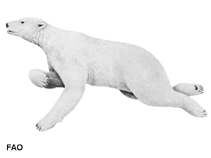| Family: |
Ursidae (bears) |
| Max. size: |
250 cm TL (male/unsexed); 200 cm TL (female); max.weight: 800 kg; max.weight: 300 kg |
| Environment: |
demersal; marine |
| Distribution: |
Atlantic Ocean and the Arctic: Ursus maritimus maritimus: Canada, Northwest Territories, Baffin Island, Greenland, Svalbard, Russia, Labrador, Newfoundland, Quebec, Iceland, Norway; Ursus maritimus marinus: Russia, Beaufort Sea, Alaska, Bering Sea, Kamchatka, Kuril Island, Sea of Okhotsk, Japan (Ref. 1522). |
| Diagnosis: |
Fur color: white, yellow, grey, or almost brown, depending on season and light conditions; black skin, including nose and lips; plantigrade; claws not retractable. |
| Biology: |
Generally associated with ice, but they have been swimming at sea many kilometers away from the nearest land. Feeds on ringed, bearded, harp and hooded seals, and rarely walruses and white whales; sometimes eat arctic cod and other forms of animal and vegetable matter (Ref. 1394). Generally associated with ice, but they have been swimming at sea many kilometers away from the nearest land. Feeds on ringed, bearded, harp and hooded seals, and rarely walruses and white whales; sometimes eat arctic cod (Ref. 1394), charr, sculpin, and plants (Ref. 81152). They display migration patterns and spend time on the ice for hunting, a positive energy state, and move to their terrestrial habitat, a negative energy state, when the ice melts. Earlier ice break-ups show earlier arrival of polar bears ashore (Ref. 93189). |
| IUCN Red List Status: |
Vulnerable (VU); Date assessed: 27 August 2015 (A3c) Ref. 123251)
|
| Threat to humans: |
|
| Country info: |
|
Source and more info: www.sealifebase.org. For personal, classroom, and other internal use only. Not for publication.

